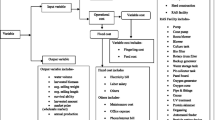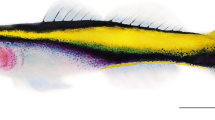Abstract
Tiger puffer (Takifugu rubripes) is one of the most expensive farmed marine fish species in China. The high profitability of farmed tiger puffer is used to attract many new investors. However, some investments failed due to a lack of information about the tiger puffer fish farm business, poor farm and facility design, and flawed investment plans. To improve the investment efficiency and profitability of this industry, this analysis evaluated the economic performance of tiger puffer from eggs to harvest size using two different open-indoor combination aquaculture systems: a combination of recirculating aquaculture system and open net pen (RAS+ONP) and a combination of flow-through system and earth pond (FTS + EP). This analysis evaluated the financial performance of both systems using profit margin, net present value (NPV), internal rate of return (IRR), and payback period. At the same time, a sensitivity analysis was employed to measure economic risk. The results revealed that despite the RAS+ONP system being more economically profitable than the FTS + EP system, the financial indicators of the FTS + EP system granted a better economic performance in terms of NPV and IRR due to lower initial investment and operating costs. Meanwhile, the sensitivity analysis revealed that the economic performance of both systems was vulnerable to the fluctuations in fish prices and feed prices. The potential risk of earning profit was higher for the RAS+ONP if the feed price fluctuated compared to the FTS + EP system, while the risk was higher for the FTS + EP if the fish price fluctuated. Hence, the FTS + EP system could represent an opportunity for new entrants to obtain a more profitable production.

Similar content being viewed by others
Data Availability
The data that support the findings of this study are available within the article.
References
Begum MK, Lalon RM, Alam ABM, Rahman MS (2022) Economic feasibility of Pabda and stinging catfish culture in recirculating aquaculture systems (RAS) in Bangladesh. Aquac Int 30(1):445–465
Bjørndal T, Tusvik A (2019) Economic analysis of land based farming of salmon. Aquac Econ Manag 23(4):449–475. https://doi.org/10.1080/13657305.2019.1654558
Bureau of fisheries, Ministry of agriculture and rural affairs, People’s Republic of China (2022) China fishery statistical yearbook. China Agriculture Press, Beijing, China
China Briefing. (2014). Obtaining land-use rights for FIEs in China. Available from https://www.china-briefing.com/news/obtaining-land-use-rights-for-fies-in-china/
Crona B, Wassénius E, Troell M, Barclay K, Mallory T, Fabinyi M et al (2020) China at a crossroads: an analysis of China's changing seafood production and consumption. One Earth 3(1):32–44
Dalsgaard J, Lund I, Thorarinsdottir R, Drengstig A, Arvonen K, Pedersen PB (2013) Farming different species in RAS in Nordic countries: current status and future perspectives. Aquac Eng 53:2–13
Davidson A (2006) The Oxford Companion to Food. Oxford University Press, p 324
Dempster T, Korsøen Ø, Folkedal O, Juell JE, Oppedal F (2009) Submergence of Atlantic salmon (Salmo salar) in sea-cages: a potential short-term solution to poor surface conditions. Aquaculture 288:254–263
Di Trapani AM, Sgroi F, Testa R, Tudisca S (2014) Economic comparison between offshore and inshore aquaculture production systems of European sea bass in Italy. Aquaculture 434:334–339
Fabinyi M, Liu N, Song Q, Li R (2016) Aquatic product consumption patterns and perceptions among the Chinese middle class. Reg Stud Mar Sci 7:1–9
FAO (2020) The state of world fisheries and aquaculture 2020. In: Sustainability in Action. Food and Agriculture Organization of the United Nations, Rome, Italy
Fernández Sánchez JL, Llorente I, Basurco B, Aguilera C (2022) Assessing the economic impact of key operational factors on grow-out farms producing European sea bass under different scenarios of production. Aquac Econ Manag 26(2):232–250
Gross R, Hanna R, Gambhir A, Heptonstall P, Speirs J (2018) How long does innovation and commercialization in the energy sectors take? Historical case studies of the timescale from invention to widespread commercialization in energy supply and end use technology. Energy Policy 123:682–699
Hou H, Zhang Y, Ma Z, Wang X, Su P, Wang H, Liu Y (2022) Life cycle assessment of tiger puffer (Takifugu rubripes) farming: a case study in Dalian, China. Sci Total Environ 823:153522
Huang CT, Afero F, Hung CW, Chen BY, Nan FH, Chiang WS et al (2022) Economic feasibility assessment of cage aquaculture in offshore wind power generation areas in Changhua County, Taiwan. Aquaculture 548:737611
Hu C, Zhang X, Reardon T, Hernandez R (2019) Value-chain clusters and aquaculture innovation in Bangladesh. Food Policy 83:310–326
Jia Y, Wang Z, Li M, Jing Q, Huang B, Zhai J, Guan C (2020) Altered hepatic glycolysis, lipogenesis, and blood biochemistry of tiger puffer (Takifugu rubripes) under two different culture systems. Aquaculture 528:735532
Jiang J, Xu J, Ye L, Sun M, Jiang Z, Mao M (2020) Identification of differentially expressed genes in gills of tiger puffer (Takifugu rubripes) in response to low-salinity stress. Comp Biochem Physiol B-Biochem Mol Biol 243-244:110437
Jia YD, Jing QQ, Zhai JM, Guan CT, Huang B (2019) Alternations in oxidative stress, apoptosis, and innate-immune gene expression at mRNA levels in subadult tiger puffer (Takifugu rubripes) under two different rearing systems. Fish Shellfish Immunol 92:756–764
Kikuchi K, Iwata N, Kawabata T, Yanagawa T (2006) Effect of feeding frequency, water temperature, and stocking density on the growth of tiger puffer Takifugu rubripes. J World Aquacult Soc 37:12–20
Kim DY, Shinde SK, Kadam AA, Saratale RG, Saratale GD, Kumar M et al (2022) Advantage of species diversification to facilitate sustainable development of aquaculture sector. Biology 11(3):368
Lim SJ, Kim SS, Ko GY, Song JW, Oh DH, Kim JD et al (2011) Fish meal replacement by soybean meal in diets for tiger puffer Takifugu rubripes. Aquaculture 313(1-4):165–170
Liu Z, Wang X, Ma A, Zhu L, Chang H, Sun Z (2022) Construction of a high-density genetic linkage map and QTL mapping of growth and cold tolerance traits in tiger puffer Takifugu rubripes. Aquaculture 561:738613
Lin Z, Wang H, Yu C, Lv F, Liu H, Zhang T (2017) Commercial production of tiger puffer (Takifugu rubripes) in winter using a recirculating aquaculture system. J Ocean Univ China 16(1):107–113
Liao K, Zhang Y, Yang Z, Shen X, Chen B (2018) Comparative analysis of the economic efficiency of Chinese sea perch farming industry. J Shanghai Ocean Univ 4:508–514
Liu Y, Tveteras S, Xie J (2021) Efficiency in Chinese large yellow croaker aquaculture: implication for sustainable aquaculture in China. Sustainability 13(24):13952
Li S, Willits DH, Browdy CL, Timmons MB, Losordo TM (2009) Thermal modeling of greenhouse aquaculture raceway systems. Aquac Eng 41(1):1–13. https://doi.org/10.1016/j.aquaeng.2009.04.002
Liu Y, Rosten TW, Henriksen K, Hognes ES, Summerfelt S, Vinci B (2016) Comparative economic performance and carbon footprint of two farming models for producing Atlantic salmon (Salmo salar): land-based closed containment system in freshwater and open net pen in seawater. Aquac Eng 71:1–12
Ma AJ, Li WY, Wang XA, Yue L, Zhuang ZM, Meng XS, Hou SY (2014) Research progress and outlook of Takifug rubripes culture techniques. Mar Sci 38(2):116–121
Maverick JB (2022) What is considered as a healthy EV/EBITDA[EB/OL]. Investopedia. https://www.investopedia.com/ask/answers/072715/
Ministry of Agriculture, Forestry and Fisheries of Japan. 2022. Statistical survey on marine fishery production. Available from:https://www.maff.go.jp/j/tokei/kouhyou/kaimen_gyosei/
Ministry of Agriculture., (2016). Notice on the conditional liberalization of processing and operation of farmed tiger puffer and farmed obscure puffer. Available from: http://www.moa.gov.cn/gk/tzgg_1/tfw/201612/t20161229_5421120.htm
Ministry of Agriculture., (2022). Notice on the list of the tiger puffer farming enterprises. Available from: http://www.yyj.moa.gov.cn/gzdt/202209/t20220929_6412268.htm
Mirzoyan N, Tal Y, Gross A (2010) Anaerobic digestion of sludge from intensive recirculating aquaculture systems. Aquaculture 306(1-4):1–6
Phillips M, Subasinghe RP, Tran N, Kassam L, Chan CY (2016) Aquaculture big numbers, vol 601. FAO Fisheries and Aquaculture Technical Paper, Rome, Italy
Sakakura Y, Takatani T, Nakayasu J, Yamazaki H, Sakiyama K (2017) Administration of tetrodotoxin protects artificially raised juvenile tiger puffer Takifugu rubripes from predators. Fish Sci 83(2):191–197
Saha P, Hossain ME, Prodhan MMH, Rahman MT, Nielsen M, Khan MA (2022) Profit and loss dynamics of aquaculture farming. Aquaculture 561:738619
Sjöberg E (2015) Pricing on the fish market—does size matter? Mar Resour Econ 30(3):277–296
Soltan, M. A. H. (2016). Aquaculture systems. Available from: https://www. researchgate. net/publication/308928410.
Villar-Navarro E, Garrido-Perez C, Perales JA (2021) Recycling “waste” nutrients back into RAS and FTS marine aquaculture facilities from the perspective of the circular economy. Sci Total Environ 762:143057
Van Rijn J, Tal Y, Schreier HJ (2006) Denitrification in recirculating systems: theory and applications. Aquac Eng 34(3):364–376
Wang QL, Zhang HT, Ren YQ, Zhou Q (2016) Comparison of growth parameters of tiger puffer Takifugu rubripes from two culture systems in China. Aquaculture 453:49–53
Wang HD, Zheng CB, Wang TY, Wang H (2020) Experiment on large scale tiger puffer pond aquaculture in Northern China. Aquaculture 12:45–48
Yang ZY, Ye ZB, Wang CX, Han ZF (2015) The difference research of formal loan in aquaculture——taking the small and medium aquaculture producers in flatfish aquaculture as an example. Chin Agric Sci Bull 31(5):265–271
Yuan Y, Yuan Y, Dai Y, Gong Y (2017a) Economic profitability of tilapia farming in China. Aquac Int 25(3):1253–1264
Yuan Y, Yuan Y, Dai Y, Gong Y (2017b) Economic profitability of tilapia farming in China. Aquac Int 25(3):1253–1264
Zhang G, Shi Y, Zhu Y, Liu J, Zang W (2010) Effects of salinity on embryos and larvae of tawny puffer Takifugu flavidus. Aquaculture 302(1-2):71–75
Zhang D, Yang ZY, Zhang YL (2017) Current status and solution of puffer fish industry in China. Sci Fish Farm (12):1–3
Zhang D, Zhang YX, Yang ZY (2019) Research on the development of China’s pufferfish aquaculture. China Fish Econ 37(4):87–96
Zheng H, Mu H, Zhao X (2018) Evaluating the demand for aquaculture insurance: an investigation of fish farmers' willingness to pay in central coastal areas in China. Mar Policy 96:152–162
Acknowledgements
The authors gratefully acknowledge the respondents in China who have extended their cooperation and support in providing their responses during the personal interview. The guidance of the Editor(s) and anonymous Reviewer(s) is gratefully acknowledged.
Funding
This study has been carried out with the financial support of the Sasakawa Scientific Research Grant from The Japan Science Society (Grant number: 2021-1028) and The Support Project for Emergent Ocean Research and Industrial Human Resource Development from the Japan Science and Technology Agency (Grant number: FY2022_JST).
Author information
Authors and Affiliations
Contributions
The first, second, and third authors contributed to the study in conceptualizing and designing it. The data collection was undertaken by the fourth and fifth author. The data analyses and interpretation were guided by the first author. The revision was undertaken by the first, second and third authors. All authors reviewed the results and approved the final version of the manuscript.
Corresponding author
Ethics declarations
Ethical approval
Not applicable.
Competing interests
The authors declare no competing interests.
Additional information
Handling editor: Gavin Burnell
Publisher’s note
Springer Nature remains neutral with regard to jurisdictional claims in published maps and institutional affiliations.
Rights and permissions
Springer Nature or its licensor (e.g. a society or other partner) holds exclusive rights to this article under a publishing agreement with the author(s) or other rightsholder(s); author self-archiving of the accepted manuscript version of this article is solely governed by the terms of such publishing agreement and applicable law.
About this article
Cite this article
Liao, K., Lou, X., Yang, Z. et al. Comparative analysis of the economic feasibility of Tiger puffer (Takifugu rubripes) aquaculture in China. Aquacult Int 32, 939–961 (2024). https://doi.org/10.1007/s10499-023-01194-5
Received:
Accepted:
Published:
Issue Date:
DOI: https://doi.org/10.1007/s10499-023-01194-5




